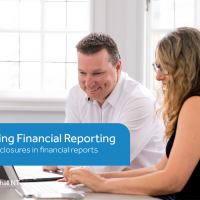2018 marks either the first year of application or the comparative reporting period for AASB 9 Financial Instruments and AASB 15 Revenue from Contracts with Customers. At the same time, many entities are also contemplating the introduction of AASB 1058 Income of Not-for-Profit Entities and AASB 16 Leases.
Accounting for revenue, leases and financial instruments will impact all industry sectors and most entities. In addition to the financial reporting result, entities’ accounting systems and processes are likely to be effected once organisations start to dissect and implement each of these new Standards. All organisations need to understand the likely changes, how these may affect their reporting and the process to implement them.
Many of you have been to presentations, read the publications and listened to the many webinars that have been provided on these new Standards. Hopefully, you are well versed in the basic principles of each Standard. But how do you actually implement these changes and what are the issues that you may have to prepare for?
Assisting with change
We have worked with many organisations providing diagnostic reports and impact assessments of AASB 9, 15, 16 and AASB 1058. A common theme throughout these engagements has been the challenge of collating and collecting the data required to apply and implement the new Standards. Obtaining and sorting through different customer contracts, leases and other documentation that could be many years old takes time, effort and sometimes a little investigation to understand the key terms and conditions of those arrangements.
Depending on the size, scale and set up of your organisation, this data gathering could take a significant amount of time. This should be factored into your diagnostic plan.
Each of the Standards contain their own key judgement areas which, whilst appearing simple in theory, could prove to be more complicated in practice. Once contracts have been obtained and understood, applying these new Standards to individual fact sets is proving to be a challenge.
For example, AASB 15 requires an identification of individual performance obligations in a contract, which may not always be clear or obvious. Where a customer contract contains multiple performance obligations, consideration is required to appropriately dissect the transaction price in the contract to those multiple elements. For example, the sale of equipment could include software upgrades, an extended warranty as well as servicing. What may have been treated as a single sale in the past has now potentially become four separate revenue recognition elements. Grants and donations are also proving challenging in the not-for-profit sector, as entities attempt to identify sufficiently specific performance obligations in order to apply deferral accounting under AASB 15.
Where these judgements are concerned, there is no one size fits all solution. You may have to review most of your outstanding revenue contracts to ensure your revenue recognition under AASB 15 is materially correct.
Judgements are also inherent in applying AASB 16. Assessing the lease term is one example. Leases that contain options to extend or terminate the lease at the decision of either the lessee or lessor can affect the assessment of the lease term. A lessee is to assess whether they are reasonably certain they will exercise the option or not and factor this into the determination of the lease term. We have seen a number of different factors affecting this assessment, including the nature of the lessee’s operations and the leased asset, the value and expected useful life of leasehold improvements, the lessee’s future business plans and other terms and conditions of the lease. Once initially assessed, systems and processes need to be implemented to review those judgements and assumptions on an ongoing basis to determine whether any remeasurement of the lease term is required.
Practically this means that someone in your organisation will be responsible for making judgements on the certainty of undertaking any options in the lease and then reassessing these if circumstances change. Organisations are considering where this responsibility should lie – finance, asset management, operations, the Board – and how this affects any delegations of authority and reporting lines.
The selection of an appropriate discount rate can be another area of significant judgement in AASB 16. Where the discount rate is not implicit in the lease, the lessee is to use its own incremental borrowing rate which should reflect a rate the lessee can borrow for an amount that is similar to the value of the right-of-use asset and for the same period as the lease term. This may not be information that is easy to obtain or estimate if the lessee does not have existing borrowings, and is often an area we see clients have practical difficulties in estimating.
Further details on the Standard are included in the Nexia Australia webinar recording An Introduction to the New Leases Standard which can be found on here.
AASB 9 presents its own challenges and can be quite complex for some organisations. Currently we are seeing many changes within financial asset classifications as a result of the previous four categories of financial assets being reduced to three, being:
- Financial assets held at amortised cost
- Financial assets at fair value through the profit and loss (FVPL); and
- Financial assets at fair value through other comprehensive income (FVOCI).
Many organisations are faced with having to dissect their current ‘Available for Sale’ asset category. With stricter definitions on what can be recognised through other comprehensive income, a lot or organisations are faced with a number of assets now being classified as financial assets at fair value through the profit and loss. In other cases, clients are revisiting their business model for holding financial assets which can impact the classification and measurement of some financial assets. Again, we have AASB 9 publications available with further details on our website.
What’s next?
Do not underestimate the time and resources required. Organisations can’t just assume that these new Standards will have no effect on their current financial reporting. Each one requires analysis, judgements, accounting estimates and policy decisions which takes time, consideration and consultation.
Furthermore, it is likely that these new Standards will change the way data is captured within some accounting systems and processes. Again, this will need time and effort to be understood and implemented.
As we move closer to June 2018 reporting deadlines, listed companies should be considering how and when they inform the market of the expected effects of these new accounting standards on their financial statements. You could need to perform this analysis sooner than you realise.
We strongly encourage our clients not to underestimate the time and work that may be required to understand the impacts of the new Standards and how these are to be implemented into their systems and controls.
How can Nexia Edwards Marshall NT help?
Our specialists can assist you analyse the potential effects of these new Standards on your operations and where any changes to your current processes and procedures may be needed.
For any questions or to discuss any of the above in relation to your organisations situation, please contact Noel Clifford or your Nexia Edwards Marshall NT Advisor.



